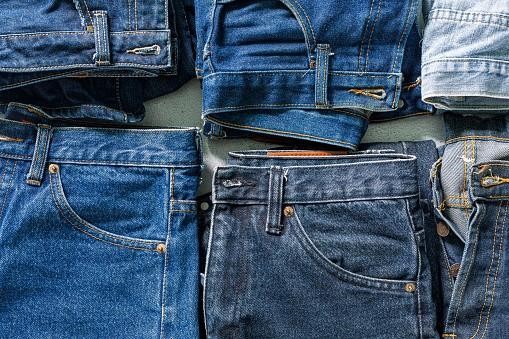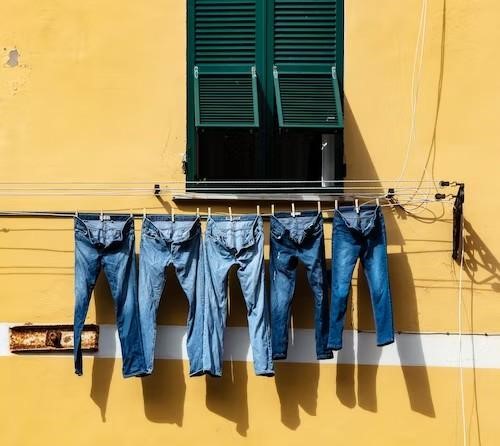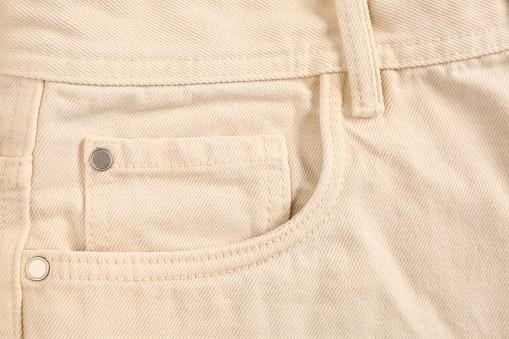
Subscribe To Emails
Subscribe to the YourCotton mailing list to receive updates on new arrivals and promotions (about once every 6 weeks)!

When it comes to denim fabric, finding the perfect fit and wash for your wardrobe can be a daunting task. With so many types of denim available, it can be challenging to determine which type you should buy. This article will explore the different types of denim fabric and provide information on what you should consider when selecting the right type for your needs.

Denim fabrics are unique in their ability to remain a classic staple for any wardrobe. While denim clothing has been around since the late 1800s, denim fabrics have come a long way. Typically denim is woven from 100% cotton, but in recent years, denim may have added polyester and Lycra for a stretchier fit. This versatile fabric can be used to create all sorts of denim clothing from denim jackets to pants and of course denim jeans.
Dry denim is often the primary choice for denim jeans due to its amazing ability to age with fray over time. However you want your denim, it is sure to remain a fashionable piece throughout the years whether on or off the runway!
Here are some of the most popular types of denim fabrics you will find in stores or online:
Raw Denim
This is a fabric of denim that has not been treated or washed at all, and it's the initial step in the fabric’s journey. The hue is deep blue and will eventually become lighter with washes. It remains stiff from being untreated, thus it’s more durable the less it’s washed. Dry denim or unwashed denim are alternative titles for this raw material.
Sanforized Denim
If you're a denim fan, then you know that ramie cotton denim material is notorious for shrinking over time, which can be disastrous if you love the look of raw denim. With sanforized denim, however, the fabric has been pre-shrunk to retain its size after washing; something that hardcore denim fans may not prefer as they enjoy the rough state of raw denim. It's important to check if your ramie cotton denim is sanforized or pre-shrunk. If it's not, buying your regular size might result in a pair of jeans that are too small — so go for one size bigger to be safe!
Indigo Dyed Denim
Indigo denim is the most popular kind of fabric on the market. Its signature blue hue comes from a dye that's applied to only one thread, while the other remains untouched, creating an eye-catching dual-color effect when you look inside any article of clothing made with this material. This unique shade originally came from a plant called indigo, though nowadays it can come in synthetic forms and still retain its title.
Color Dyed Denim
Sulfur dye has revolutionized the denim industry, allowing for the production of a variety of colored denim jeans and other apparel. In addition to your classic blue denim, you can now find dyes that range from mustard yellow to green and gray tones, while also including shades of red or pink. Don't be afraid to experiment with different fabrics either! Fantastic options include marble denim, reverse denim, and waxed reverse denim. Whichever dyed fabric you choose, you are sure to get an eye-catching look with any colored denim option.
Selvage Denim (Selvedge Denim or Self-Edge)
Selvage denim is distinguished by the hued bands that line the sides to prevent fraying. Generally, when selvage edges are used in jean construction, they indicate a superior quality product. While red or orange colorations may be most common, this depends on who made them and can come in any other colors too! Rather than using selvages though, some jeans opt for raw edging with an overlock seam, which also helps stop fraying from occurring.
Acid Wash Denim

For an iconic acid-wash denim look, pumice stones soaked in chlorine are used to scrub the fabric for a faded and mottled design. Alternatively, chemical acids can also be put into the wash cycle for the same effect. This stylish aesthetic was especially popular in the 1980s, but has been revived numerous times since then.
Stone Wash Denim
To achieve the coveted lived-in look, stonewash is done with pumice stones to eliminate dye and abrade the fabric. Compared to other methods, it's more difficult to control, which may result in an uneven finish. Unfortunately, though, items made from these types of denim will not last as long.
Crushed Denim
Crushed denim is designed to have an intentionally wrinkled, crumpled look. To create a truly worn effect, it can be combined with other processes such as acid or stone wash. The wrinkles created by the crushing process will not fade away even when washed numerous times!
Poly Denim
Combining the best of both worlds, poly-cotton fibers are blended to craft a soft denim fabric that is becoming increasingly popular in clothing.
Stretch Denim
Denim fabric can be infused with Spandex and Lycra to provide an optimum level of stretch, making it a dream for any fashion enthusiast. This type of denim is perfect for those tight-fitting jeans that we all love and it provides you the comfort you need throughout your day.
Bull Denim
Bull denim is a dependable and resilient type of cotton fabric that can be used for numerous applications, such as upholstery, curtaining, clothing items, and more. It boasts an impressive selection of colors with an even dyeing process to ensure a consistent hue throughout every piece. Its distinct weaving pattern makes it smoother on one side than the other — all while staying strong enough to account for its heavy-duty usage!
Ecru Denim

Ecru denim is a unique fashion look that involves leaving the natural color of cotton as is, meaning without any dye. This casual style provides a neutral, understated look and offers a wardrobe classic for anyone looking for something different.
If you’re looking to make a bold statement, ecru denim is not for you as its beauty lies in its subtle and sophisticated tone. Its natural hue means it pairs nicely with many colors, making it easy to mix and match with existing pieces already in the closet. It adds an instant chic factor no matter how dressed up or down you want to go!
Organic Denim
Organic denim is not just a healthier option when compared to regular denim, but it's also created without the use of any harsh chemicals in either growing or manufacturing the cotton. It's an all-natural and environmentally conscious choice that you can feel good about wearing.
There are a variety of denim fabrics available, each with its unique benefits. When choosing a type of denim fabric for your next project, consider the end use of the garment or item. Denim that will be used for high-stress areas like pockets or hemlines may benefit from a sturdier weave, while softer denim might be better suited for garments that drape well. Whichever type of denim you choose, make sure to test out a sample before committing to a larger purchase.